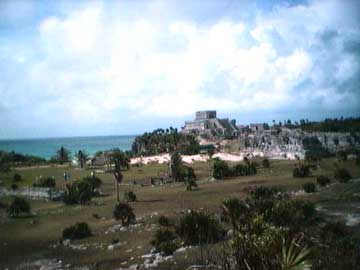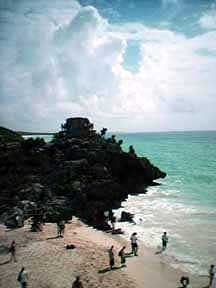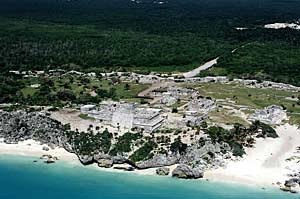
Tulum Ruins
 Tulum's
on a beautiful site
Tulum's
on a beautiful site
Tulum is the most important archeological site on Mexico's Caribbean coast. At the end of the Classic period, 900 AD, the Mayan civilization began to decline. In this Post Classic period, small rival city states developed, such as Tulum. Tulum is protected on one side by ocean cliffs, and on the others by a stone wall. It was founded around 1200 as a commercial trading port, and reached its height of importance in the 1400s. The city was occupied at the time of the Spanish conquest, and survived for 70 years after the Spanish arrived. Although the city is not considered as impressive as Chichen Itza or Uxmal, its seat on a Caribbean coast makes it a beautiful and unique place to visit.
There are plenty of inexpensive hotels near the Tulum Mayan ruins in the Tulum Hotel Zone.
The ruins are small and manageable.
The ruins are small enough to cover in an hour or so. Afterwards, a trip to the snorkel park Xel Ha or the cenotes on the Cobá road is a great way to cool off. There is a beach in the ruins - a delightful place to swim right under the imposing Castillo. There are signs in English, Spanish and Mayan describing the major structures.
 Just
in past the main entrance to the ruins is the "Temple of the Frescoes".
The walls inside the temple are painted with a mural honoring the "Diving
God" and the goddess of corn. The Diving God is the most important
god in Tulum. He is interpreted to be god descending from the heavens
to receive the offerings of men. The corners outside the temple are decorated
with stucco masks.
Just
in past the main entrance to the ruins is the "Temple of the Frescoes".
The walls inside the temple are painted with a mural honoring the "Diving
God" and the goddess of corn. The Diving God is the most important
god in Tulum. He is interpreted to be god descending from the heavens
to receive the offerings of men. The corners outside the temple are decorated
with stucco masks.
The "Castillo" is the largest building on the site. It was a temple and fortress. Like all of the buildings here, it was once covered in stucco and painted. Tulum is so busy that tourists are not allowed to climb the buildings because it would damage them. The top of the building served as a guide for boats looking for the one entrance through the reef into the harbor.
The "Temple of the Winds" is to the North of the Castillo, perched over the water. Rumor has it that it served as a warning system for hurricanes. Supposedly, the temple whistled when Roxanne reached hurricane force winds in 1995.
Go in the morning.
Tulum can get crowded and hot, so it is best to visit in the morning
before the cruise boat and bus groups arrive around 10:00. It is easy
to get buses to the ruin entrance and there is parking for a minimal
fee. The large visitor's center is a collection of shops and restaurants,
from h ere
you can either walk 15 minutes down the road to the entrance to the ruins,
or pay $2 to take the shuttle round trip (worth it on a hot day).
ere
you can either walk 15 minutes down the road to the entrance to the ruins,
or pay $2 to take the shuttle round trip (worth it on a hot day).
Entrance to the ruins is free on Sunday, and costs $4 during the rest of the week. Brining in a video camera costs an extra $4. Guides are available to make your tour more interesting, look for their official badges. Even so, getting a licensed guide will not protect you from misinformation about the Mayans being aliens or the lost tribe of Israel. Take what they have with a grain of salt, and enjoy the stories they tell.

Incidents
of Travel in Yucatan First published in 1843, a travelogue from one
of the first tourists to the Yucatan.
[ About Cancun South | Clients | Awards ]
© Property of Cancun South ™ and PlayaLink
SA de CV with offices in Playa del Carmen, Mexico
Cancun South ™ phrase, website content and images not to be used
without permission from the webmaster
